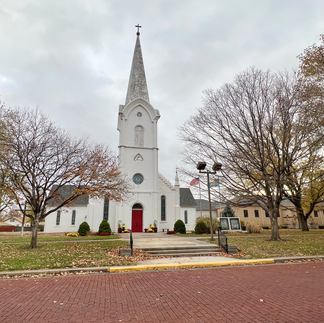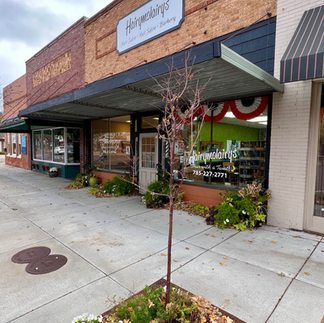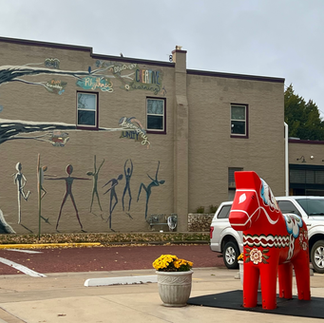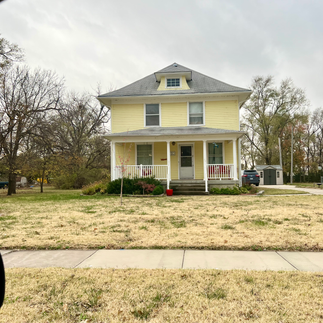North Platte, Nebraska
November 11, 2022
I deviated from my original path to check out Lindsborg. It is a pretty little town with a busy business district. Lots of art shops. It was a cheerful way to start my day. Lindsborg is the home of Bethany College, known appropriately, as the Swedes.
Lindsborg has a nine-hole golf course that was closed for the season.
More brick streets!
If I didn't know I had some Swiss blood in me, I would guess I was part Swede.
A fun town to visit!
Lindsborg is a city in McPherson County, Kansas. As of the 2020 census, the population of the city was 3,776. It is known for its large Swedish, other Nordic and Scandinavian Americans (Nordic-Scandinavian), and German heritages, It is home of the biennial Svensk Hyllningsfest.
For many millennia, the Great Plains of North America were inhabited by nomadic Native Americans. From the 16th to the 18th century, the Kingdom of France claimed ownership of large parts of North America. In 1762, after the French and Indian War, France secretly ceded New France to Spain, per the Treaty of Fontainebleau. In 1802, Spain returned most of the land to France. In 1803, the land for modern day Kansas was acquired by the United States from France for 2.83 cents per acre as part of the 828,000 square-mile Louisiana Purchase.
In 1854, the Kansas Territory was organized and in 1861 Kansas became the 34th U.S. state. McPherson County, which included the land for the future Lindsborg, was established in 1867. Lindsborg was settled in the spring of 1869 by a group of immigrants from the Värmland province of Sweden led by Pastor Olof Olsson. In 1879, the same year Lindsborg incorporated as a city, the first railroad came through.
Lindsborg translates as Linden Castle from Swedish to English, referring to a tree name known in Europe for a species of tilia (Swedish: lind). The community is named for four men whose surnames included "Lind", N. P. Linde, S. P. Lindgren, S. A. Lindell, and J. O. Lindh, who had held prominent positions in a Chicago organization of Swedish farmers (Svenska Lantbrukskompaniet or First Swedish Agricultural Company) which was involved in the settling of Lindsborg until 1877.
Thirty percent of the current residents are of Swedish descent. Because the town has retained so much of the heritage of its founders, it has become known as "Little Sweden".[8] The downtown features gift shops that specialize in Swedish souvenirs, including various sizes of Dala horses. Lindsborg has long been noted for the Svensk Hyllningsfest, a biennial celebration held in October of odd-numbered years since 1941, and other efforts to honor its heritage.
Lindsborg is the home of the Swedish Pavilion, which was originally constructed as an international exposition building for the 1904 St. Louis World's Fair. After the fair, it was purchased by W. W. Thomas, U.S. Minister to Sweden and Norway, and presented to Lindsborg's Bethany College as a memorial to his friend Dr. Rev. Carl Aaron Swensson, the school's recently-deceased founder. At Bethany, it was used by the art department as a classroom, library, and museum. It was moved to the McPherson County Old Mill Museum, also in Lindsborg, in 1969.
The Birger Sandzén Memorial Gallery is located in Lindsborg. Dedicated on October 20, 1957, on the Bethany College campus, it showcases the works of the artist Birger Sandzén who lived in the city. The gallery houses the largest and most extensive collection of his paintings, prints, and drawings found anywhere in the world.
Swedish King Carl XVI Gustaf visited Lindsborg in April 1976 during his royal tour of the United States.
In 2004, Lindsborg was named Chess City of the Year by the United States Chess Federation.
Bethany College
Bethany College is a private Christian college, founded in 1881, making it one of the oldest colleges in Kansas. It has approximately 900 students.
History
Bethany College, established by Swedish Lutheran immigrants in 1881, is a college of the Evangelical Lutheran Church in America (ELCA). Swedish-Lutheran settlers worked with the Rev. Carl Aaron Swensson, pastor of Bethany Lutheran Church, to establish Bethany Academy on October 15, 1881, in the sacristy of the church in Lindsborg, Kansas, with ten students. The first building erected contained classrooms and a dormitory for men. A separate dormitory for women was built next. J. A. Udden was the first teacher. In 1882, the Smoky Valley district of the Kansas conference of the Augustana Synod took responsibility for the college; a board of directors was appointed and a state charter was received.
In 1883, a large dormitory for men was constructed, and in 1885, a main hall with classrooms, a chapel museum, and library and science departments opened. The Kansas conference itself took responsibility for the school in the spring of 1885 and the name was changed to Bethany College and Normal Institute. By 1889, its present name, Bethany College, had been assumed and it had been granted permission to award academic degrees.
Notable Bethany presidents in the 20th century include Rev. Ernst Frederick Wilhelm Pihlblad (1873–1943), who was a professor from 1895 to 1904 and president from 1905 to 1941. Under Pihlblad, Bethany was accredited and became a member of the National Association of Schools of Music. Under the watch of Emory K. Lindquist (1908–1992), who took office of president in 1943, Bethany survived war troubles, grew in post-war America, and improved its reputation. He was the author of Bethany in Kansas: The History of a College (1975).
Academics
Bethany College has 14 academic departments. The school offers majors focused in education, humanities, fine arts, sciences, and social sciences; minors ranging from business and sacred music to theater and art; teaching endorsements for all majors in education; and six pre-professional studies including medicine, law and, physical therapy.
Athletics
The Bethany athletic teams are called the Swedes (or Terrible Swedes). The college is a member of the National Association of Intercollegiate Athletics (NAIA), primarily competing in the Kansas Collegiate Athletic Conference (KCAC) since the 1902–03 academic year.
Bethany competes in 22 intercollegiate varsity sports: Men's sports include baseball, basketball, cross country, football, golf, soccer, tennis, track & field (indoor and outdoor) and wrestling; while women's sports include basketball, cross country, golf, soccer, softball, tennis, track & field (indoor and outdoor) and volleyball; and co-ed sports include cheerleading, dance and eSports.

In case you were wondering about the Swedish horse thing ....
A Dalecarlian horse or Dala horse (/ˌdɑːləˈkɑːrliən/; Swedish: Dalahäst) is a traditional carved, painted wooden statue of a horse originating in the Swedish province of Dalarna (Dalecarlia). In the old days the Dalecarlian horse was mostly used as a toy for children; in modern times it has become a symbol of Dalarna, as well as of Sweden in general. Several types of Dalecarlian horses are made, with distinguishing features common to the locality of the site where they are produced. One particular style has, however, become much more common and widespread than others. It is stoutly carved and painted bright red with details and a harness in white, green, yellow and blue.
History
The wooden horses are painted in the kurbits style.
The carving of Dala horses as a livelihood is thought to have started in the village of Bergkarlås [sv] in central Sweden, though the nearby "horse" villages of Risa [sv], Vattnäs, and Nusnäs were also centres of horse-making. The villages were involved in the art of furniture and clock-making, and it is likely the leftover scraps of wood were put to use in the production of Dala horses. Many early Dala horses were not painted at all, but in the beginning of the 19th century painting them in a single color, white or red, became common practice. The decoration of the Dala horse has its roots in furniture painting and was perfected over the years. According to a local tale, a wandering painter in the style of kurbits came across one of these Dala horses in a farm he was decorating. When asked by one of the children why that horse was not as beautifully painted as the ones in the decorations, he painted the Dala horse in the same style. This tradition was then carried on in order to raise the market value of the Dala horses.
The earliest references to wooden horses for sale are from 1623. In the 19th century, Stikå Erik Hansson [sv] from the village Risa in the parish of Mora introduced the technique of painting with two colours on the same brush, still used today. In the book "The Wooden Horses of Sweden," the author mentions that this famous Dala painter is buried in a small churchyard in Nebraska after having immigrated to the Midwest in 1887 at the age of 64. He changed his name to Erik Erikson upon coming to America and is buried at Bega Cemetery in Stanton County Nebraska, outside of Norfolk.
While there were many horse whittlers in the early production of Dala horses, there were comparatively few horse painters. The large number of whittlers and a lack of distinguishing features makes it difficult to distinguish between different whittlers. Early painters very rarely signed their work, but they did have their own distinct pattern from which it is often possible to identify who painted a particular horse. In the 1930s (especially after the World's Expo in Paris 1937 and World's Fair in New York 1939 in which Dala horses were shown) mass production of Dala horses started. This marks the beginning of a new era for the Dala horse, transitioning from toy to a national symbol and popular souvenir.
The Dalecarlian horse of today is still a handcrafted article, made of pine, and its pattern is about 150 years old. At least nine different people contribute their skills to create each horse. The distinctive shape of the horse is due to the usage of flat-plane style carving.
Folklore and popular culture
An apocryphal legend of the Dalecarlian horse is that they became the national toy in 1716. According to the legend, soldiers loyal to King Charles XII were quartered in the Dalecarlian region and carved the toys as gifts for their hosts.
In the 2003 Norwegian film Kitchen Stories, a small Dala horse is part of a joke when a character expected a real horse as a reward.
Geographical differences
Early production of Dala horses was concentrated to four villages: Bergkarlås, Risa, Vattnäs, and Nusnäs, all in the parish of Mora. Production is believed to have started in Bergkarlås and later spread to nearby villages Risa and Vattnäs through kindred. At about the same time production started independently in Nusnäs, and being farther away their style was less influenced by those of the other villages. The individual painters each had their particular style, and the few who are old enough to remember first- or second-hand the history can often tell which village, and in some cases which carver or painter, turned out a particular horse. The distinguishing features of many early painters from these villages have now been documented.
Many of the works by the earliest horse makers are no longer in existence but those that remain are cherished by their owners and have often been passed down through generations. These are also coveted by collectors, and their value has risen markedly over the years.
Today, many of the villages in Dalarna county make Dala horses with individual styles representing the district of origin. These horses also have distinctive shapes and often come in different sizes. Some horses like the Nusnäs horse are stocky work horses; others are lean and upright with stately countenance like the Rättvik horse. Many of these can be seen at a yearly exhibition (since the year 2000), which is held at Klockargården in Leksand, Sweden. Currently about forty present carvers and painters show their Dala horses and put them up for sale.
Production
Today, Nusnäs is the centre of Dala horse production with the most famous being the Nils Olsson and Grannas Olsson workshops. Grannas A. Olssons Hemslöjd AB, founded in 1922, is the oldest company which still makes Dalecarlian horses. Nils Olssons Hemslöjd is almost as old. The horses made at these workshops share the same familiar pattern which most people associate to Dala horses. Apart from these, old-style horses are also hand-carved and painted in limited editions to replicate the style of the antique horses found in Swedish museums or held in private family collections. These are numbered and signed, so that they cannot be confused with an original early Dala horse.
The wood from which the figures are carved comes from the slow-growing pine forests around Lake Siljan. The wood is ideal for carpentry and carving. The trees to be made into horses are marked out while still standing in the forest. Only the best timber will be selected for carving into horses. The trees are felled and sawed into pieces of a suitable size for the blanks that will eventually be made into Dalecarlian horses.
The blanks are sawed and carved by hand. Because of this, no two horses are exactly alike. The horses are dipped in primer immediately after carving, to reveal any defects in the wood that may need to be fixed. After priming, any cavities in the wood are filled in to ensure extra smoothness. The horses are polished to give them a smooth, attractive finish.
After sanding, the horses are dipped into paint of the appropriate colour. The traditional pattern is painted free-hand by practised "ripple" painters. The art of rippling requires great skill and takes many years to learn. Finally, "all the fine horses" are varnished and sent out from Nusnäs to serve as a symbol of Sweden in the outside world.
Dala horses in the United States
Dala horses were introduced to North America at the 1939 World's Fair in New York. The architects Sven Markelius and Anders Beckman chose the dala horse because they were searching for a powerful symbol for the Swedish pavilion at the fair.


































































They have a WONDERFUL Festival every year!!! The town is transformed!